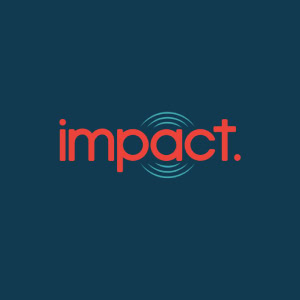Relieve Muscle Tension With Trigger Point Dry Needling in Perth
Experience targeted relief from tight, overworked muscles. Our clinicians offer trigger point dry needling in Perth to support pain management and muscle recovery.

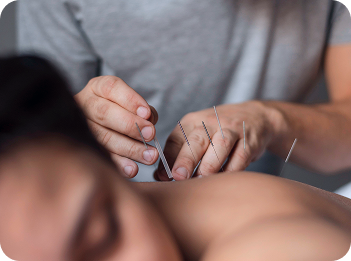
What Makes Trigger Point Dry Needling a Targeted Approach
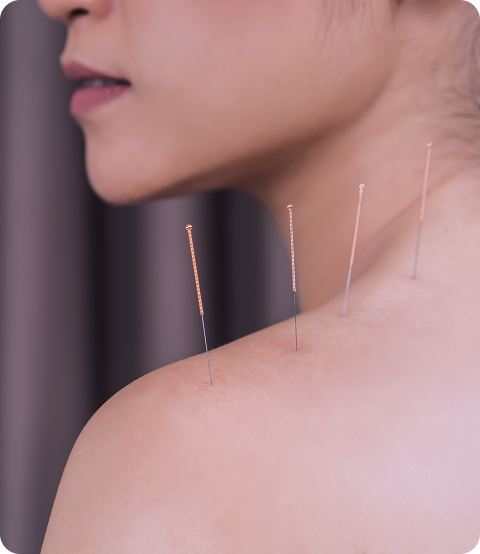
Trigger point dry needling involves the use of fine, sterile needles to target myofascial trigger points—tight, sensitive knots within muscle fibres. These points often cause localised pain, stiffness, or referred discomfort. The needles help release muscle tension, stimulate blood flow, and activate the body’s natural healing process to reduce muscular dysfunction.
Trigger Point Areas Addressed By Dry Needling
Neck and Shoulder Tension
Muscle knots in the neck and shoulders often cause stiffness and limited mobility. This area responds well to dry needling for myofascial pain, which targets tight bands to ease discomfort.
Lower Back Discomfort
Lower back tension may stem from prolonged sitting, poor posture, or strain. Trigger point muscle therapy offers targeted relief, reducing tightness and improving spinal support.
Tension-Type Headaches
Overactive muscles in the neck or upper back can lead to headaches. Dry needling for tension headaches may help release trigger points contributing to cranial and facial pain.
Hip and Gluteal Tightness
Tight glutes and hip flexors can restrict walking or sitting. Dry needling helps relax overactive tissues, supporting postural alignment and reducing joint strain.
Hamstring and Calf Muscle Fatigue
Overworked hamstrings and calves can feel heavy or tight post-activity, especially after running or prolonged standing. Dry needling for myofascial pain promotes local circulation, easing soreness and enhancing muscle recovery.
Jaw or Facial Muscle Tightness
Stress-related clenching may cause facial or jaw tension, often leading to discomfort while speaking or chewing. Targeted dry needling releases overactive points, improving comfort and reducing strain on surrounding tissues.
Neck and Shoulder Tension
Muscle knots in the neck and shoulders often cause stiffness and limited mobility. This area responds well to dry needling for myofascial pain, which targets tight bands to ease discomfort.
Lower Back Discomfort
Lower back tension may stem from prolonged sitting, poor posture, or strain. Trigger point muscle therapy offers targeted relief, reducing tightness and improving spinal support.
Tension-Type Headaches
Overactive muscles in the neck or upper back can lead to headaches. Dry needling for tension headaches may help release trigger points contributing to cranial and facial pain.
Hip and Gluteal Tightness
Tight glutes and hip flexors can restrict walking or sitting. Dry needling helps relax overactive tissues, supporting postural alignment and reducing joint strain.
Hamstring and Calf Muscle Fatigue
Overworked hamstrings and calves can feel heavy or tight post-activity, especially after running or prolonged standing. Dry needling for myofascial pain promotes local circulation, easing soreness and enhancing muscle recovery.
Jaw or Facial Muscle Tightness
Stress-related clenching may cause facial or jaw tension, often leading to discomfort while speaking or chewing. Targeted dry needling releases overactive points, improving comfort and reducing strain on surrounding tissues.
A Guide on What to Expect During a Dry Needling Session
Initial Consultation &
Discussion
The session begins with a discussion about your symptoms, health history, and goals. Your clinician will explain how dry needling fits into your overall care plan.
Identifying Trigger Points
The practitioner will gently palpate muscles to locate tight, tender spots. These trigger points are the focus of treatment, often linked to pain or restricted movement.
Needle Insertion & Technique
A fine, sterile needle is inserted into each identified trigger point. You may feel a brief twitch or pressure, followed by a sense of muscle release.
Post-Treatment Advice
You will receive advice on aftercare, including hydration and gentle movement. Mild soreness is common, and your clinician will guide you through managing recovery at home.
The Benefits of Trigger Point Dry Needling in a Clinical Setting
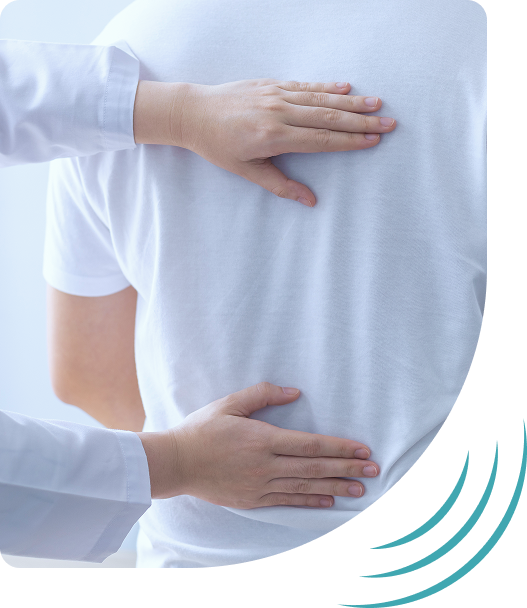
Benefits
- Dry needling helps reduce muscle tightness and localised pain by releasing overactive trigger points. This may contribute to improved movement patterns over time, depending on individual response.
- It enhances your body's healing response by improving local circulation and easing physical stress. This can be particularly helpful after injury, overuse, or prolonged muscle strain.
- Improving flexibility and joint range of motion is a key benefit. Dry needling may help alleviate stiffness caused by tight, shortened, or compensatory muscle groups.
Limitations
- Mild post-treatment soreness or fatigue may occur, especially after the first session. This is short-lived and typically settles within one or two days.
- Dry needling may not be suitable for everyone. It may be avoided if you're pregnant, have certain medical conditions, or feel anxious about needles or intramuscular techniques.
- Treatment outcomes can vary depending on your condition, activity levels, and care plan. Significant improvement is often seen when combined with other therapies or guided rehabilitation.
Could You Be a Suitable Candidate for Dry Needling?
Dry needling may be appropriate if you’re experiencing muscle-related discomfort or movement issues. Your clinician will evaluate your symptoms and health history to determine if it’s right for you.

Persistent muscle tightness
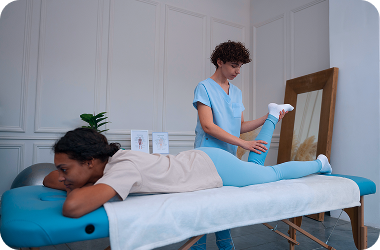
Localised musculoskeletal pain
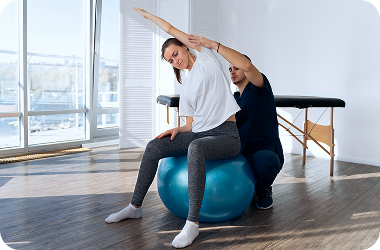
Reduced flexibility or mobility
Why Choose Us for Trigger Point Dry Needling Therapy
Explore how our approach to trigger point dry needling combines skilled delivery with gentle techniques designed to ease tension and improve movement.
Therapists Who Listen And Adapt
Your experience matters to us. We begin each session with a careful discussion to understand what you're feeling, where discomfort is showing up, and how it’s affecting your movement. We don’t just follow a script—we adapt our dry needling approach based on your feedback and goals. You’re an active part of the process, not just a passive participant.
Gentle Technique With Measurable Focus
Dry needling can be precise and comfortable when done right. We use a gentle approach that targets trigger points without overloading your system. Each needle placement is guided by years of training and a deep understanding of muscular patterns, helping you feel relief without unnecessary discomfort. You’re supported throughout, with time to pause, breathe, and ask questions whenever you need.
Modern Care Backed By Research
Our team stays updated on the latest clinical evidence behind dry needling and pain science. From managing muscle tightness to supporting athletic recovery, our protocols are built on real-world results, not just trends. We’re passionate about combining evidence with empathy to provide safe, thoughtful care that supports your long-term wellbeing.
A Supportive Space To Recover
We know muscle pain can affect more than just your body—it can disrupt work, sleep, and peace of mind. That’s why we’ve created a calm, welcoming clinic where you can feel safe letting go of tension. Whether you’re coming in after a tough week or prepping for a return to sport, you’ll find care that feels human, not clinical.
Book a Trigger Point Dry Needling Session in Perth Today
Get to Know Nicholas Wigger
With nearly 20 years in physiotherapy, Nicholas Wigger has played a key role in shaping the use of dry needling in Australia. Based in Perth, he brings a patient-first mindset to every consultation—listening closely, tailoring treatment plans, and focusing on outcomes that support daily comfort and movement.

Nick Wigger
Advanced Level 3 GEMt Dry Needler
- MD, PhD
- 15+ Years
“Dry needling should never feel mechanical—it’s about adapting to what each person needs and helping them move forward with clarity and confidence.”
Cost and Payment Options
Initial Consultation
Lorem ipsum dolor sit amet, consectetur adipiscing elit. Ut elit tellus, luctus nec ullamcorper mattis, pulvinar dapibus leo.
$149.00
AUD
- This 30-minute session includes a full evaluation of your condition, symptoms, and treatment needs.
- Your practitioner will explain the dry needling techniques and answer any questions you may have before the treatment begins.
- A personalised treatment plan will be created, and your first session will be completed.
Standard Consultation
Lorem ipsum dolor sit amet, consectetur adipiscing elit. Ut elit tellus, luctus nec ullamcorper mattis, pulvinar dapibus leo.
$149.00
AUD
- This 15-minute session includes a brief review of your symptoms and any changes since your last visit.
- Your clinician will provide focused dry needling to one or two key muscle areas.
- You’ll also receive post-treatment advice to support at-home care and recovery.
Extended Consultation
Lorem ipsum dolor sit amet, consectetur adipiscing elit. Ut elit tellus, luctus nec ullamcorper mattis, pulvinar dapibus leo.
$220.00
AUD
- This 30-minute session is suitable for patients with complex conditions or those requiring treatment in multiple areas during a single visit.
- Your practitioner will combine advanced dry needling with clinical movement evaluation during the 30-minute session.
- You will leave with tailored recovery guidance and recommendations for ongoing care or exercise.
Frequently Asked Questions About Trigger Point Dry Needling
Understanding the advantages of shockwave therapy can help you decide about this treatment option. Here are some common questions about shockwave therapy and insightful answers to clarify its key benefits and applications.
What does trigger point dry needling do to muscles?
Trigger point dry needling offers several direct effects on muscle tissue, particularly when used to manage myofascial pain and dysfunction:
- Releases tight muscle fibres: The needle stimulates overactive trigger points, causing the muscle to relax. This promotes immediate muscle release with dry needling, helping reduce stiffness and improve comfort.
- Improves local circulation: Needle insertion boosts blood flow around the affected area. This increase in oxygen and nutrient delivery helps flush out metabolic waste and facilitates the recovery process.
- Interrupts pain signals: The process reduces chemical irritation and alters the way nerves transmit pain signals. Dry needling for myofascial pain may help calm the nervous system and relieve referred pain.
- Restores muscle function: By reducing tension and normalising electrical activity in the muscle, dry needling can help restore normal movement patterns and joint range of motion.
When provided by trained professionals, dry needling is a safe and effective way to support muscular recovery and relieve tension-related discomfort.
How does trigger point dry needling differ from acupuncture?
Although both therapies involve the use of fine needles, they differ significantly in philosophy, technique, and application. Here’s how they compare across key aspects:
- Foundational Principles
Acupuncture is based on traditional Chinese medicine, aiming to balance the flow of energy (Qi) through specific meridian points. Dry needling is guided by Western anatomical and neurological understanding.
- Purpose and Focus
Acupuncture supports overall wellness by regulating the flow of energy. Dry needling aims to release overactive muscular fibres and improve function through local muscle stimulation.
- Target Areas
Acupuncture needles are placed on mapped energy points. Dry needling targets myofascial trigger points and tight muscle bands, often using intramuscular stimulation therapy techniques.
- Clinical Use
Acupuncture is generally used as a holistic modality. Dry needling is often integrated into physiotherapy or rehabilitation to support recovery and mobility.
- Treatment Sensation
Acupuncture is usually subtle and relaxing. Dry needling may cause a twitch or ache, which indicates effective stimulation of the target muscle.
If you’re exploring care for muscle tightness or tension, trigger point therapy in Perth may offer a targeted, clinically grounded approach.
How long does it take for trigger points to heal after dry needling?
Most people experience noticeable improvements within a few sessions. Clinical studies have shown that pain relief and trigger point sensitivity can improve within 4 to 12 weeks. Many patients experience sustained benefits around the 6-week mark.
Key factors that affect this timeline include the following:
- Severity and chronicity: Long-standing or complex muscle tension generally takes longer to ease than recently developed issues.
- Health, age, and healing ability: Individuals in good health and younger people tend to respond more quickly to treatment.
- Movement patterns and posture: Repetitive strain or poor posture can reactivate trigger points, extending recovery time.
- Frequency of sessions: Regular sessions combined with guided exercises help maintain consistent improvements.
- Lifestyle and self-care: Adequate hydration, rest, and stress management support faster healing of muscle tissue.
This evidence supports the benefits of muscle release with dry needling. It also highlights the role of this technique as part of non-invasive pain management in Perth, supporting gradual and effective recovery from muscular tension.
Why do I feel sore or tired after trigger point dry needling?
It’s normal to feel mild soreness or fatigue after dry needling. This often feels like post-exercise tightness and usually settles within 24 to 48 hours. This phenomenon happens as your muscles respond to the needle’s stimulation.
Dry needling for myofascial pain targets deep fibres, which can make them temporarily tender or sensitive. Tiredness may follow as your body adapts and clears out byproducts released during muscle release. Such discomfort is a common occurrence, especially in early sessions.
If you’re receiving dry needling treatment for chronic muscle tightness, post-session fatigue can be exacerbated by long-standing muscle tension. To support your recovery, consider the following:
- Drink plenty of water after your session.
- Do gentle movements or stretching to stay mobile.
- Rest if needed, especially if you feel unusually worn out.
Is dry needling covered by Medicare in Australia?
Dry needling itself is not covered as a standalone Medicare service. However, it may be included as part of a physiotherapy session funded under a GP Chronic Condition Management Plan (GPCCMP).
Eligible patients may access up to five Medicare-subsidised allied health visits per calendar year through this plan. These sessions may involve one type of therapy or a combination of therapies, such as physiotherapy, podiatry, or dietetics, based on the GP’s referral.
Some dry needling in physiotherapy clinics may be included if they form part of a physiotherapy session approved under the plan. Your GP will determine if this procedure is appropriate based on your health needs.
If you’re exploring options for trigger point therapy in Perth, speak to your GP about your eligibility for a GPCCMP. They can advise whether physiotherapy with dry needling can be included in your care plan.
What happens if a nerve is hit during dry needling?
It’s rare for a needle to touch a nerve during dry needling. If it does happen, you might feel a quick, sharp sensation, tingling, or a sudden muscle twitch. These feelings are usually brief and go away shortly after the needle is moved. Your clinician will check in with you and adjust the needle if anything feels unusual or uncomfortable.
Muscle release with dry needling focuses on tight muscle fibres, not nerves; however, some parts of the body are more sensitive than others. Speaking up during your session helps your practitioner make safe adjustments.
In dry needling treatment for chronic muscle tightness, deeper muscles may respond more strongly. Your practitioner will work carefully to avoid areas that may cause discomfort and keep you informed throughout the process.
If something feels unusual, inform your clinician. They’re trained to make changes to keep you comfortable and safe.
Who should not undergo trigger point dry needling?
Dry needling is considered safe for most people when performed by trained clinicians. However, it may not be suitable in certain situations, depending on your health and comfort level.
You may need to avoid dry needling in the following situations:
- You have a strong fear of needles or feel very anxious during procedures involving needles.
- You are pregnant, especially during the first trimester, and have not discussed this with your GP.
- You have a medical condition that affects blood clotting, skin healing, or immune response, which may increase risk or discomfort.
Intramuscular stimulation therapy, such as dry needling, involves working directly on muscle fibres. It may not be suitable for people with certain nerve conditions or complex health concerns.
At Impact Dry Needling Clinic, we carefully evaluate every patient. This helps us determine whether dry needling or another option for non-invasive pain management in Perth is the right fit for you.
How many sessions of trigger point dry needling are usually needed?
The number of sessions varies depending on your condition and how your body responds to treatment. Some people notice improvement after one or two sessions, while others benefit from additional sessions.
Your clinician may recommend a short course of sessions spaced over time. This helps release tight muscle fibres, reduce discomfort, and facilitate better movement.
A few factors that may influence how many sessions you need include the following:
- The severity and duration of your muscle tightness can affect how quickly your body responds.
- You may require additional sessions if your condition has been present for an extended period or is more complex.
- Some people respond quickly to dry needling, while others require more time to notice significant improvement.
- If your job, sport, or daily activity places strain on your muscles, additional sessions may be needed.
- Your clinician may recommend combining dry needling with other supportive therapies, which can influence the number of sessions required.
At Impact Dry Needling Clinic, we provide personalised guidance to help you get the most from trigger point dry needling in Perth. Your plan will be adjusted as your symptoms change over time.
What should I avoid after a dry needling session?
After dry needling, your muscles may feel tender or slightly fatigued. Being mindful in the hours following your session helps reduce discomfort and maintain the benefits of trigger point muscle therapy.
Here’s what to avoid and why:
- Strenuous exercise or heavy lifting: Intense activity can increase post-session soreness and stress muscles that were just released.
- Alcohol consumption: Alcohol may dehydrate you and interfere with your body’s natural recovery process.
- Heat or ice packs without advice: Applying heat or cold too soon can affect blood flow and muscle response. Check with your clinician before using them.
- Massage on the needled area: Further stimulation might increase tenderness or delay muscle settling after your session.
- Prolonged sitting or inactivity: Staying in one position for too long may cause tightness to return. Light walking or movement is encouraged.
By avoiding these activities temporarily, you give your muscles time to adapt and recover more comfortably.
Can dry needling be used for tension headaches or migraines?
Yes, dry needling may help with tension-type headaches by releasing tight muscles in the neck and shoulders. These muscles can contribute to headache symptoms through referred tension.
Dry needling for tension headaches targets specific trigger points linked to muscular stress. While it’s not a treatment for migraines, some people with muscle-related triggers may notice relief.
At Impact Dry Needling Clinic, we can evaluate your symptoms and determine whether this approach is suitable for your needs.
How deep do the needles go during trigger point dry needling?
The depth of needle insertion depends on the targeted muscle and your anatomy. Some muscles are located just under the skin, while others require deeper access to reach the affected area.
Clinicians may use either a shallow or deeper technique, depending on the area and your comfort. In most cases, the goal is to stimulate the muscle’s trigger point safely and effectively. Dry needling techniques can range from superficial insertion to deeper muscle targeting, depending on the approach used.
At Impact Dry Needling Clinic, we apply precise techniques to provide safe and effective trigger point therapy in Perth.
What’s the difference between dry needling and trigger point injections?
Both techniques focus on relieving muscle tension, but they differ in how they’re performed and who can provide them.
- Dry needling uses a fine, solid needle without medication. Trained clinicians commonly perform dry needling in physiotherapy clinics to target muscle trigger points and improve function.
- Trigger point injections involve a medical doctor injecting a small amount of anaesthetic or medication into the muscle. This technique is often used when inflammation or severe pain is present.
Dry needling is considered a non-pharmacological approach, while trigger point injections involve medicine and require medical authorisation. Your choice depends on your condition and referral pathway.
Need more information?
Location
Surgeons House, 162 Cambridge Street, West Leederville WA
Email Us
Call Us
Working Hours
Tuesday to Friday: 9:00 AM - 5:00 PM
Saturday to Monday: CLOSED
